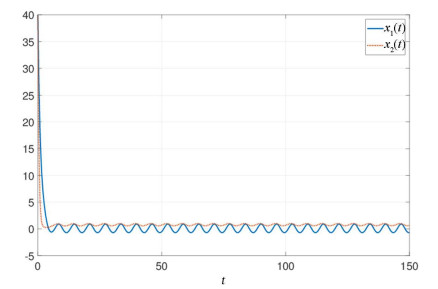1 引言
本文的结构如下.首先是预备知识,包括一些必要的定义、假设以及引理.第3部分讨论模型的全局吸引集.第4部分列举例验证主要结果.第5部分给出结论.
2 预备知识
本文中,
我们考虑如下具有变时滞的神经型Hopfield神经网络模型
模型(2.1)由一元神经域
系统(2.1)的初始条件是
我们定义如下符号
为了方便进一步讨论,我们给出如下假设,定义及重要引理.
(A1)对任意
(A2)对
(A3)对
(A4)
(A5)对某些
定义2.1 如果对任意常数
定义2.2 如果存在一个紧集
其中
定义2.3 如果系统(2.1)是一致有界并且有一个全局吸引集
定义2.4[28] 设
则称
引理2.1[37] 对任意非负矩阵
引理2.2 令
若满足如下条件
(ⅰ)
(ⅱ)
则存在常数向量
证 由条件(ⅱ)和引理2.1,
假设(2.3)式不成立,则一定存在一个常数
其中
不失一般性,我们假设存在一个常数
考虑到表达式(2.2), (2.4)和
这与等式(2.5)矛盾,因此不等式(2.3)成立.证明完毕.
3 主要结论
定理3.1 假设(A1)-(A4)成立,则系统(2.1)一致有界.
证 由条件(A1),对任意
从而
由(A2)可得
由(3.1)和(3.2)式,可得
结合(3.3)式,条件(A3), (A4)和引理2.2,可得存在一个常数向量
即系统(2.1)的解关于局部状态
注3.1 由(3.4)式易得每个解的分量的有界性.
定理3.2 假设满足(A1)-(A5),则集合
为系统(2.1)的全局吸引集,即系统(2.1)为全局Lagrange稳定.
证 由定理3.1,存在一个非负常数向量
下面我们将证明
由条件(A5)和定义2.4,
当
由(3.6)和(3.7)式,可推得对于
根据上极限的定义和
其中
因此,结合条件(A3), (3.3)和(3.8)-(3.10)式,可得对任意
再由(3.5)式和上极限定义,存在
令
和
即
注3.2 显然,如果系统(2.1)有一个全局吸引集,则系统(2.1)的解一致有界.
注3.3 若把平衡点作为吸引集的特殊情况,则Lyapunov稳定为Lagrange稳定的特例.因此,如果系统存在平衡点,定理3.2的结论课用于讨论Lyapunov稳定性.
定理3.3 假设定理3.2的所有条件成立及
4 数值举例
例4.1 考虑如下模型
其中
和
定理3.2中所有的条件都满足,所以存在
为系统(4.1)的全局吸引集.
图 1
5 结论
基于积分不等式和非负矩阵的性质,考虑了变时滞神经型Hopfield神经网络模型,得到了保证系统Lagrange稳定和全局吸引集的充分条件.并且,本文的方法可以用来研究平衡点的全局渐近稳定性.
参考文献
Hyperchaos and bifurcation in a new class of four-dimensional Hopfield neural networks
DOI:10.1016/j.neucom.2005.11.001 [本文引用: 1]
Stability and bifurcation of a class of discrete-time neural networks
Chaos of a new class of Hopfield neural networks
Bifurcation analysis for a discrete-time Hopfield neural network of two neurons with two delays and self-connections
DOI:10.1016/j.chaos.2007.01.126
Some novel double-scroll chaotic attractors in Hopfield networks
DOI:10.1016/j.neucom.2010.02.015
Hopf bifurcation stability in Hopfield neural networks
DOI:10.1016/j.neunet.2012.09.007
Bifurcations and chaos in a discrete-time-delayed Hopfield neural network with rings tructures and different internal decays
DOI:10.1016/j.neucom.2012.06.007
Generation of cyclic/toroidal chaos by Hopfield neural networks
DOI:10.1016/j.neucom.2014.05.038
On a discrete-time-delayed Hopfield neural network with ring structures and different internal decays: Bifurcations analysis and chaotic behavior
DOI:10.1016/j.neucom.2014.06.079 [本文引用: 1]
Anti-periodic solutions for high-order Hopfield neural networks with impulses
DOI:10.1016/j.neucom.2014.01.028 [本文引用: 1]
Existence and exponential stability of periodic solution for stochastic Hopfield neural networks on time scales
DOI:10.1016/j.neucom.2015.04.038
Piecewise pseudo-almost periodic solution for impulsive non-autonomous high-order Hopfield neural networks with variable delays
DOI:10.1016/j.neucom.2015.07.054 [本文引用: 1]
Multistability in impulsive hybrid Hopfield neural networks with distributed delays
DOI:10.1016/j.nonrwa.2010.10.018 [本文引用: 2]
Simplified stability criteria for fuzzy Markovian jumping Hopfield neural networks of neutral type with interval time-varying delays
DOI:10.1016/j.eswa.2011.11.055
Stability analysis of fractional-order Hopfield neural networks with time delays
DOI:10.1016/j.neunet.2014.03.012
Global stability analysis of fractional-order Hopfield neural networks with time delay
DOI:10.1016/j.neucom.2014.12.031
New delay-dependent stability criteria for switched Hopfield neural networks of neutral type with additive time-varying delay components
DOI:10.1016/j.neucom.2014.10.014
Stability analysis of Hopfield neural networks perturbed by Poisson noises
DOI:10.1016/j.neucom.2016.02.034
Stability analysis of fractional-order Hopfield neural networks with discontinuous activation functions
DOI:10.1016/j.neucom.2015.07.077 [本文引用: 2]
Positive invariant and global exponential attractive sets of neural networks with time-varying delays
DOI:10.1016/j.neucom.2007.07.017 [本文引用: 2]
Cocycle attractors in nonautonomously perturbed dif- ferential equations
Dissipative functional differential equations
Autonomous and non-autonomous attractors for differential equations with delays
Pullback and forward attractors for a damped wave equation with delays
Attractors for 2D-Navier-Stokes models with delays
Delay-range-dependent control synthesis for time-delay systems with actuator saturation
DOI:10.1016/j.automatica.2008.03.009 [本文引用: 2]
Integro-differential equations and delay integral inequalities
DOI:10.2748/tmj/1178227303 [本文引用: 3]
Invariant set and attractor of nonautonomous functional differential systems
DOI:10.1016/S0022-247X(02)00370-0
Attracting and invariant sets for a class of implusive functional defferential equations
DOI:10.1016/j.jmaa.2006.05.072
The exponential asymtotic stability of singularly perturbed delay differential equations with a bounded lag
DOI:10.1016/S0022-247X(02)00056-2
Exponential stability of nonlinear implusive neutral differential equations with delays
Global exponential stability of impulisive reaction-diffusion equation with variable delays
Global attracting set for non-autonomous neutral networks with distributed delays
DOI:10.1016/j.neucom.2012.04.020
Lagrange stability for delayed recurrent neural networks with Markovian switching based on stochastic vector Halandy inequalities
DOI:10.1016/j.neucom.2017.10.006
Global exponential stability of neutral-type octonion-valued neural networks with time-varying delays
DOI:10.1016/j.neucom.2018.05.004



